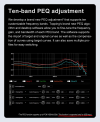fatoldgit
Addicted to Fun and Learning
- Joined
- Feb 29, 2020
- Messages
- 536
- Likes
- 764
thanks and that's disappointing
Well, this is obviously their first shot at it, we can all expect more of it later on (and not just the far more expensive D90 III discrete)thanks and that's disappointing
But not at this price.we can all expect more of it later on (and not just the far more expensive D90 III discrete)
XMOS can receive spdif as seen in their example code, eval boards etc. It seems to be a Topping design decision.But not at this price.
You need a proper DSP or CPU to do that on all inputs, I suppose.
Hi,XMOS can receive spdif as seen in their example code, eval boards etc. It seems to be a Topping design decision.
The next generation DACs with 10-band PEQ that works for all inputs, were already shown by Topping at the CanJam NYC.
The D90 III Discrete is based on a new discrete 1-bit DAC module using a positive and negative 16-element DAC for each channel.
Another more advanced DAC is the D900 which also comes with a 10-Band PEQ, but adds a much nicer display with a spectrum analyzer and other VU styles.
The D900 is based on the same DSM module but using a positive and negative 32-element DAC for each channel.
Both DACs will be probably shown at the Highend show in Munich.
Are these DACs the new RME ADI-2 DAC killer?
Surely they don't make their own DACs at Topping. So those would be the current models from AKM or ESS since there is noone else left in the high end of the market.
This one dates back to 2020.
At the time it was scoring as the best SINAD DAC measured by Amir.

Mola Mola Tambaqui DAC and Streamer Review
This is a review and detailed measurements of the Mola Mola Tambaqui USB DAC and Ethernet streamer. It is on kind loan from a member which is quite special when you consider it costing US $11,500 (£8,999). As it should be the Tambaqui weights a lot relative to its size with generous use of...www.audiosciencereview.com
They're fairly nicely made already. It's an aluminum housing, feels much more solid than pictures would make you think.
There is a separate USB connector for power. If it is connected, the bus power of the data connector is not used, as the DAC negotiates as self-powered. Especially mobile devices have issues supplying significant amounts of bus power, so a separate power connector improves compatibility. Any USB power supply works, well-known brands are recommended. I don't know if phones come bundled with chargers anymore, but these are usually well-built.Users of Topping D50 III, this Dac uses the USB type power and the product page says " It is recommended to add auxiliary power supply for better performance "
What does that auxiliary power supply mean ? Can we use LPS ? How does that improve the performance ?
Thanks for your response @AtanasiThere is a separate USB connector for power. If it is connected, the bus power of the data connector is not used, as the DAC negotiates as self-powered. Especially mobile devices have issues supplying significant amounts of bus power, so a separate power connector improves compatibility. Any USB power supply works, well-known brands are recommended. I don't know if phones come bundled with chargers anymore, but these are usually well-built.
EQ can be saved and selected as a preset on the device, but the EQ is only audible in USB modethanks and that's disappointing
According to Topping, EQ is only applied to USB audio:EQ can be saved and selected as a preset on the device, so it also works with BT or other sources, only editing and creating a PEQ is done via the PC in USB mode !

yes the display of the device is deceptive, the settings are also visible in BT mode, but they actually do not work - unfortunately it is true - I have had the device since today - I thought at first it would work
Yep,they can't.So, once the eq curves have been set and stored with USB, cannot be applied to other inputs than USB?